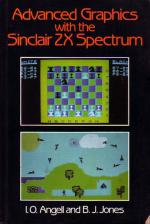
ZX Computing
 1st October 1983
1st October 1983
Categories: Review: Book
Author: Patrick Cain
Publisher: Macmillian
Machine: Spectrum 48K
Published in ZX Computing #9
Advanced Graphics With The Sinclair ZX Spectrum
Advanced Graphics With The Sinclair ZX Spectrum should on successful completion enable the reader to produce screen displays on par with anything available commercially.
Now for the bad news. Such ability is not easily gained and to understand the text fully, a good deal of previous knowledge is necessary. The authors, both members of the Department of Computer Science, University of London, are undoubtedly well qualified to instruct on computer graphics and their work has produced an almost complete textbook for the subject.
It is intended, according to the introduction, that the book may be read on different levels - either to simply gain from it the graphic displays provided by the listings therein, or to understand how those displays have been produced and then be capable of equivalent ingenuity. I would suggest that the cost of £9.95 would be prohibitive if your intention is only to realise the former.
By understanding the text the reader on completion will understand the theory and techniques of producing pie charts, bar charts, geometric drawings, engineering drawings and arcade-type video games. Before undertaking study of the book, the reader should have a good working knowledge of Basic and some knowledge of machine code. No knowledge of graphics at any level is necessary, the authors rightly feel that any knowledge of graphics necessary will be given in the book. Further it is recommended that readers should be familiar with cartesian co-ordinates. I would suggest that a knowledge of geometry and algebra beyond this will be required in order that the reader may concentrate on the graphics theory content rather than the mathematics.
Throughout the discussion it is assumed that a 48K is being used, although an appendix does give notes on how and where to make alterations should be 16K version by used. The approach has been to accompany each piece of theory with a worked example, similar to the method of maths or physics books. Where problems are likely to become over-complex or involve a modular approach has been adopted, breaking each larger work area into smaller more readily understandable ones. Without doubt this is effective, allowing the reader to progress at his or her own pace and to move forward when the reader feels he or she has mastered what has gone before. In this way, no body of work ever seems inconquerable.
Chapter one looks at those commands which are concerned with graphics. I hope I won't be accused of shrinking from my task if I say that the following chapters analyse and explore what can be achieved by implementing these commands and their mathematical and computing aspects. Significant graphic displays will not be possible without an understanding of the mathematics used to generate them. It should be understood then that the maths can get heavy. It is the nature of any advanced study to be beyond the scope of one book where, in order to keep this book to a finite size, it has been necessary to restrict a discussion; however, further reading has been recommended.
Chapter fourteen, by way of a conclusion, looks at a practical video game and, with reference to what has gone before, examines it to discover how it was constructed. Chapter fifteen points to how this newly acquired skill and knowledge can be put to use by suggesting some major graphics projects; by this stage they should be within the ability of the reader.
The book aims at truly 'advanced' graphics in design and implementation and thus it does require a serious study and degree of commitment. The rewards it will pay are high.
Advanced Graphics With The Sinclair ZX Spectrum is written by I. O. Angell and B. J. Jones. It is published by Macmillan Press and costs £9.95. ISBN 0 333 35050 2.
Scores
Spectrum 48K Version| Overall | 91% |


